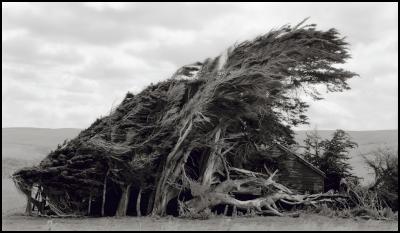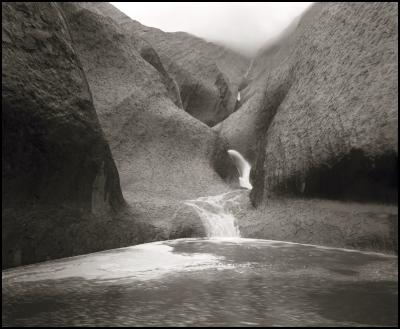“Nature” : An exhibition by Nathan Ross
Media Release 16 August 2009
“Nature” : An exhibition by Nathan Ross

Click for big version
Abandoned House, for Reasons Unforeseen (2006)

Click for big
version
Mutitjulu Waterhole, Uluru (2008)
“Nature” is a new exhibition by
Wellington-based photographer, Nathan Ross, showing at the
Photospace Gallery, Wellington from the 18th of
September.
Nathan says his aim is to present an honest view of the natural environment.
The black and white images, with subjects from Wellington, throughout NZ and outback Australia, explore the tension between untouched nature and human encroachment.
Nathan uses a traditional large format camera (5x4 inch negatives) to create a dreamlike set of images that mourn an environment under threat, but still retain a sense of love and optimism.
“We are used to images showing the environment as pure and untouched, but knowing what we know about climate change, threats to wildlife, deteriorating water quality, and other environmental problems, it’s impossible to take such images at face value."
Despite the serious theme underlying Nathan’s work, he enjoys the irony that sometimes results from the struggle between nature and human beings.
In ‘Abandoned House, for Reasons Unforeseen’, a windbreak set up to provide shelter ends up enveloping a house, making it unliveable. In ‘Barrel Flax (Phromium spp.)’, a 44-gallon drum appears to be the fruit of a flax, resulting in both pathos and humour.
“To me, these are more realistic landscape scenes,” Nathan says. “While there are plenty of remnants of untouched wilderness, we mostly live in competition with natural systems.
“That said, some of my works are about also our positive relationships with Nature.
“Uluru [a.k.a. Ayres Rock] and Kata Tjuta [a.k.a. The Olgas] are central to Aboriginal relationships to the Earth, so that’s why I’ve included images of them in an exhibition here in Wellington. I was privileged to be at Uluru during heavy rain, so I could experience and capture some very rare scenes.”
Nathan was born and raised in Sydney. He has a Diploma of Photography and a Bachelor of Environmental Science. He moved to Wellington in 2005 and works on sustainable energy projects.
Exhibition
details
Photospace Gallery, Level 1, 37 Courtenay Place,
Wellington.
18 September to 10 October 2009. Opening
preview 5pm-7pm, Friday 18 September.
Nathan Ross –
Artist’s Statement
Living within the natural environment, to respect and protect its intrinsic and utilitarian values, is fundamental to my value system. So, for me, photography is an expression of that respect, and a way of expressing my fears and frustrations about society’s determined path and instinctive optimism, regardless of the realities of Nature.
We show no signs of
abating the behaviour that is undermining environmental
systems, despite the evidence of that damage and our
intrinsic relationship to Nature:
• Nature subsuming
human spaces – see ‘Abandoned House, for Reasons
Unforeseen’ (2006) and ‘Justice and the Old Court’
(2005);
• Our carelessness taking root – see
‘Barrel Flax (Phromium spp.) ’ (2006) and ‘Rubber
Trees’ (2007);
• Apparently-robust but
actually-sensitive ecosystems that will be affected by rapid
climate change, including the coastlines that will be
drowned by rising sea levels – see ‘High Tide Zone,
Pakawau’ (2006) and ‘Moeraki Boulders’
(2006);
• Natural spaces that offer awe and inspiration
– see ‘Ancient Rata’ (2005) and ‘Mutitjulu
Waterhole, Uluru’ (2008).
The planet’s natural systems do not consider our well-being or wreak havoc as ‘Mother Nature’. They just exist by chance. They are reactive, intertwined and extraordinarily complex systems, and we keep saying we will manage and adapt to these systems’ reactions to our over-harvesting (of forests, fisheries, soils, water…) and over-polluting (of the atmosphere, waterways, soils…) at some undetermined time in the future through market mechanisms.
We could barely be more entrenched in optimism and denial than to act as though our fundamental life support systems are something that will be managed successfully in the future by experts in the narrow, subjective and ethically indifferent fields of economics and commerce.
To express the themes of optimism and denial, I choose an aesthetic that is both dream-like and ghost-like, presenting individual subjects as desirable, or fading, or both.
Method
My technique is a combination of traditional and contemporary methods.
Photographs are taken with a large format camera on black and white film. (One image was made on medium format film.) Because of its cumbersome and manual nature, and its expense, large format photography demands that I am considered and committed to making images throughout the entire process: Loading film into the dark slides Leaving the house with a 20 kilogram pack Finding subjects Setting up the equipment Making compositions Waiting for the right conditions Releasing the shutter.
This discipline ensures that I have considerable focus on (1) choice of subject, (2) the subjects’ shapes, patterns, lines and textures, (3) how light is affecting those elements, and (4) ensuring those elements work harmoniously through composition and other decisions.
In addition to the mindfulness that large format photography imposes, it allows me to capture exquisite tones and details. It also has ‘movements’, whereby the lens and film can be moved in many different ways independently from one another. I often exploit these movements to create various effects in-camera to help achieve my aesthetic.
Once processed, I scan my negatives to make digital files. Editing is limited to basics such as removing marks on the negative, contrast, dodging and burning, and colour balance. Giclée prints are done on 100% cotton archival papers.
Exhibitions
• Nature, solo exhibition,
Photospace Gallery, Wellington, September/October
2009.
• Architecture – An Interpretation, merit
award, Ministry for the Environment’s Urban Design Art
Awards, Shed 11, Wellington, December
2005.
• Architecture – An Interpretation, solo
exhibition, Photospace Gallery, Wellington, October/November
2005.
• Architecture, collection, Recovery Room
restaurant, Wellington.
• Nathan Ross, photographer
profile, The Ebony Gallery, www.ebonycamera.com.
Training and learning
• Bachelor of Environmental Science,
1996-98, University of Newcastle, Australia. Major in
Environmental Management, focusing on ecology and
ethics.
• Self-taught photography, 1999-2001, prior to
and during overseas travel.
• Diploma of Photography,
2002-06, Sunshine Coast Institute of TAFE, Australia. This
course introduced me to a broad range subjects, techniques,
and photographers with their vast array of motivations and
styles.
• On-the-job learning, 2004-05 in commercial
photography for portraits, products, editorial, real estate,
and events.
• In the last four years, I’ve been
studying photography and creativity more intensively,
questioning my motivations; what I am trying to convey; how
I’m going to get there.
Biography
I was born and grew up in Sydney, Australia. After completing school, I worked for the Department of Social Security (1992-1996) administering child disability allowances and family payments.
After completing a Bachelor of Environmental Science, I moved to the Sunshine Coast, Queensland. There, I worked on environmental education and climate change projects for the local council (1999-2005), except for 14 months (2000-01) in England, spent working as a live-in carer, travelling to Iceland (natural history), Eastern Europe (war history) and France (art history), and teaching myself photography.
I moved to Wellington, New Zealand in 2005 to continue working on climate change and sustainable energy programmes.
Artistic influences (in no particular order)
• Sally Mann (USA)
• Julia Margaret
Cameron (UK)
• John Dugdale (USA)
• Wayne Barrar
(New Zealand)
• Peter Dombrovskis
(Australia)
• Joyce Campbell (New Zealand)
• Scott
Freeman (New Zealand)
• Karl Blossfeldt
(Germany)
• Annie Liebowitz (USA)
• 19th Century
photography
• Alternative process
photography
ENDS


 University of Auckland: Tributes Flow For Much Loved Pacific Leader Melegalenu’u Ah Sam
University of Auckland: Tributes Flow For Much Loved Pacific Leader Melegalenu’u Ah Sam NZEI: Ministry Of Education Cuts Will Disproportionately Affect Pasifika
NZEI: Ministry Of Education Cuts Will Disproportionately Affect Pasifika Day One Hapai te Haeata: Call To Action For Young Filmmakers Against The Backdrop Of Funding Cuts
Day One Hapai te Haeata: Call To Action For Young Filmmakers Against The Backdrop Of Funding Cuts Toyota New Zealand: Three Races For Top Three To Decide TR86 Title
Toyota New Zealand: Three Races For Top Three To Decide TR86 Title Wellington City Council: Wellington Is All Action Stations For The Faultline Ultra Festival
Wellington City Council: Wellington Is All Action Stations For The Faultline Ultra Festival Melanie Allison: Local Playwright Casts A Spell Over Hamilton
Melanie Allison: Local Playwright Casts A Spell Over Hamilton